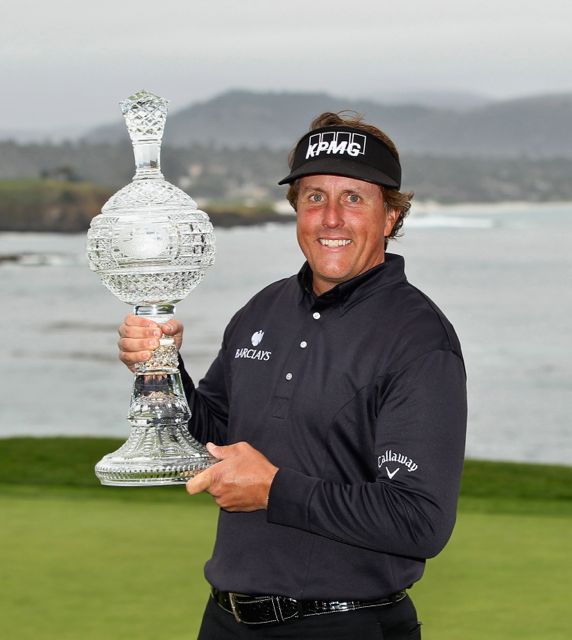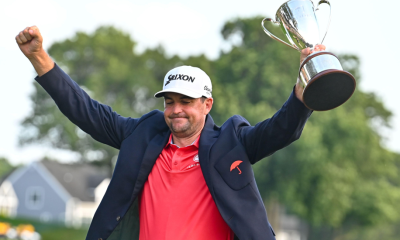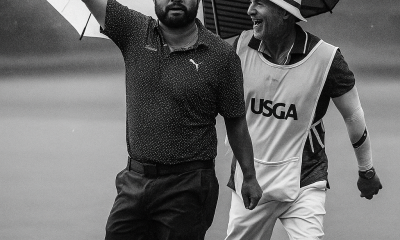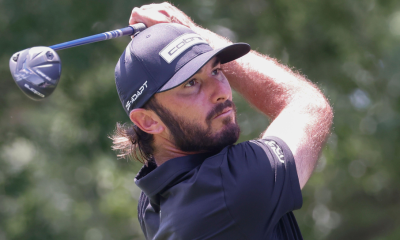Opinion & Analysis
The Real Top 10: PGA Tour Power Rankings

PGA Tour player performance is something that fans and media alike are always measuring and sharing their opinions about. When these matters are discussed between friends, enemies, co-workers, spouses, in-laws – there is always some disagreement. Some people like to measure the entire season’s performance when evaluating a golfer, and some employ the “What have you done for me lately?” school of thought. I always thought there was something to be said for both sides.
I wanted to find a way that I can measure a Tour player’s performance over the course of a season, but also keep in mind how hot (or cold) a player is to help me predict what they may (or may not) do in the future. The FedExCup standings does a good job of tracking a player’s season, but let’s look at it this way: if you only played in two PGA Tour tournaments and won them, you would have 1,000 FedEx Cup points (assuming one of them wasn’t a major). With those numbers at playoff time, you could play in every other tournament, not make a cut, and be in the top 30 in the FedEx cup standings! What I’m telling you is that you can’t judge a golfer by those standings alone.
So I invented a system that takes those FedExCup standings, puts them through a series of number crunches and put together my own Power Ranking to give you a mix of how good these players actually are, meshing together their season performance and recent performance in an effort to quell the arguments between you and your loved (or not so loved) ones.
Let’s take a look at who owns the top ten spots going into the AT&T Pebble Beach National Pro-Am.
1. Brandt Snedeker
It’s no surprise that the guy who has three top-3s to start the 2013 season is No. 1 on this list. Starting off his year with a third place finish at The Hyundai Tournament of Champions and putting together back-to-back second place finishes these last two weeks, Sneds is showing us that he wants to be the first person ever to defend their FedEx Cup title.
2. Phil Mickelson
With a dominating performance at the Waste Management Phoenix Open, highlighted by his first round performance where he had a chance of shooting a 59 on TOUR, this west coast swing is where Phil does damage. You have to believe after the week he’s had, and going up to Pebble Beach this week to a tournament that he won last year, he will be the favorite to win.
3. Brian Gay
With a win at the Humana Challenge and a respectable T24 finish at the Phoenix Open, Gay is putting together a great start to his season. The 41-year-old tends to have good early season form shown, which is confusing because he has not put himself in the field this week at Pebble, a tournament he finished T20 at last year.
4. Russell Henley
You’ve got to be impressed with a 23 year-old that wins the first full-field tournament of the year, which was also his first start as a PGA Tour rookie. He has made the cut in all three of his starts this season, where he has only shot one round over par. There is a host of young talent on tour right now, and Henly is poised to show us that he can compete with the best.
5. Charles Howell III
Howell already has three top-10 finishes in 2013, including a playoff loss to Brian Gay at the Humana Challenge. He’s taking a week off this week after playing four consecutive weeks, but look for him on the front page of leader boards in the tournaments to come.
6. Dustin Johnson
DJ came out with guns blazing in 2013, taking home a trophy in the winners-only Hyundai Tournament of Champions. We know what Johnson can do off of the tee, but the improvement in his short game has been scary good over the past years, increasing his rank in Strokes Gained-Putting from 171st in 2011, to 51st last year. With this much of a short game improvement, look for him at the top of the leader board this week at the AT&T Pebble Beach National Pro-Am, which he won in 2009 and 2010.
7. Bubba Watson
Bubba put together a good start to his season, finishing T4 the Tournament of Champions and solo 15th at the Phoenix Open. He recent years, the 2012 Masters champ has really turned himself into an all-around player, instead of just being known for his long ball. He hasn’t shot a round over par yet this season, and finished off the Phoenix Open with a bogey free round of 7-under 64.
8. Ryan Palmer
Ryan Palmer put together a hot start to his 2013 campaign, his best start since 2010, picking up two top-10s in his first three events. Most recently, he notched a solo 5th place finish this past week in Phoenix. He has been hitting the ball beautifully, and he will be looking to keep this hot start going this week at Pebble Beach, a tournament where he finished T29 last year.
9. Robert Garrigus
Garrigus has had an absolutely sensational start to his year by finishing T16, T6, and T11 in his three starts so far. Robert has been long off the tee, averaging over 306 yards, and has hit almost 78 percent of greens in regulation. That is going to be a killer combination this week if he can keep up this stellar ball striking trend, going to a tournament where he finished T20 last year.
10. Nick Watney
The Nike newcomer rounds out the top 10 this week by way of a T13 finish in Kapalua, along with a T4 at the Farmers Insurance Open. It seems that Nick has taken a liking to his new equipment, because he has been striking the ball wonderfully to start off the year. Watney will be in the field for the Pro-Am as he has been his entire career, where he hasn’t missed a cut since 2004. Over that span, he has also managed to pick up two top-10s. Expect more of the same this year.
Click here for more discussion in the “Tour Talk” forum.
Opinion & Analysis
The 2 primary challenges golf equipment companies face

As the editor-in-chief of this website and an observer of the GolfWRX forums and other online golf equipment discourse for over a decade, I’m pretty well attuned to the grunts and grumbles of a significant portion of the golf equipment purchasing spectrum. And before you accuse me of lording above all in some digital ivory tower, I’d like to offer that I worked at golf courses (public and private) for years prior to picking up my pen, so I’m well-versed in the non-degenerate golf equipment consumers out there. I touched (green)grass (retail)!
Complaints about the ills of and related to the OEMs usually follow some version of: Product cycles are too short for real innovation, tour equipment isn’t the same as retail (which is largely not true, by the way), too much is invested in marketing and not enough in R&D, top staffer X hasn’t even put the new driver in play, so it’s obviously not superior to the previous generation, prices are too high, and on and on.
Without digging into the merits of any of these claims, which I believe are mostly red herrings, I’d like to bring into view of our rangefinder what I believe to be the two primary difficulties golf equipment companies face.
One: As Terry Koehler, back when he was the CEO of Ben Hogan, told me at the time of the Ft Worth irons launch, if you can’t regularly hit the golf ball in a coin-sized area in the middle of the face, there’s not a ton that iron technology can do for you. Now, this is less true now with respect to irons than when he said it, and is less and less true by degrees as the clubs get larger (utilities, fairways, hybrids, drivers), but there remains a great deal of golf equipment truth in that statement. Think about it — which is to say, in TL;DR fashion, get lessons from a qualified instructor who will teach you about the fundamentals of repeatable impact and how the golf swing works, not just offer band-aid fixes. If you can’t repeatably deliver the golf club to the golf ball in something resembling the manner it was designed for, how can you expect to be getting the most out of the club — put another way, the maximum value from your investment?
Similarly, game improvement equipment can only improve your game if you game it. In other words, get fit for the clubs you ought to be playing rather than filling the bag with the ones you wish you could hit or used to be able to hit. Of course, don’t do this if you don’t care about performance and just want to hit a forged blade while playing off an 18 handicap. That’s absolutely fine. There were plenty of members in clubs back in the day playing Hogan Apex or Mizuno MP-32 irons who had no business doing so from a ballstriking standpoint, but they enjoyed their look, feel, and complementary qualities to their Gatsby hats and cashmere sweaters. Do what brings you a measure of joy in this maddening game.
Now, the second issue. This is not a plea for non-conforming equipment; rather, it is a statement of fact. USGA/R&A limits on every facet of golf equipment are detrimental to golf equipment manufacturers. Sure, you know this, but do you think about it as it applies to almost every element of equipment? A 500cc driver would be inherently more forgiving than a 460cc, as one with a COR measurement in excess of 0.83. 50-inch shafts. Box grooves. And on and on.
Would fewer regulations be objectively bad for the game? Would this erode its soul? Fortunately, that’s beside the point of this exercise, which is merely to point out the facts. The fact, in this case, is that equipment restrictions and regulations are the slaughterbench of an abundance of innovation in the golf equipment space. Is this for the best? Well, now I’ve asked the question twice and might as well give a partial response, I guess my answer to that would be, “It depends on what type of golf you’re playing and who you’re playing it with.”
For my part, I don’t mind embarrassing myself with vintage blades and persimmons chasing after the quasi-spiritual elevation of a well-struck shot, but that’s just me. Plenty of folks don’t give a damn if their grooves are conforming. Plenty of folks think the folks in Liberty Corner ought to add a prison to the museum for such offences. And those are just a few of the considerations for the amateur game — which doesn’t get inside the gallery ropes of the pro game…
Different strokes in the game of golf, in my humble opinion.
Anyway, I believe equipment company engineers are genuinely trying to build better equipment year over year. The marketing departments are trying to find ways to make this equipment appeal to the broadest segment of the golf market possible. All of this against (1) the backdrop of — at least for now — firm product cycles. And golfers who, with their ~15 average handicap (men), for the most part, are not striping the golf ball like Tiger in his prime and seem to have less and less time year over year to practice and improve. (2) Regulations that massively restrict what they’re able to do…
That’s the landscape as I see it and the real headwinds for golf equipment companies. No doubt, there’s more I haven’t considered, but I think the previous is a better — and better faith — point of departure when formulating any serious commentary on the golf equipment world than some of the more cynical and conspiratorial takes I hear.
Agree? Disagree? Think I’m worthy of an Adam Hadwin-esque security guard tackle? Let me know in the comments.
@golfoncbs The infamous Adam Hadwin tackle ? #golf #fyp #canada #pgatour #adamhadwin ? Ghibli-style nostalgic waltz – MaSssuguMusic
Podcasts
Fore Love of Golf: Introducing a new club concept

Episode #16 brings us Cliff McKinney. Cliff is the founder of Old Charlie Golf Club, a new club, and concept, to be built in the Florida panhandle. The model is quite interesting and aims to make great, private golf more affordable. We hope you enjoy the show!
Opinion & Analysis
On Scottie Scheffler wondering ‘What’s the point of winning?’

Last week, I came across a reel from BBC Sport on Instagram featuring Scottie Scheffler speaking to the media ahead of The Open at Royal Portrush. In it, he shared that he often wonders what the point is of wanting to win tournaments so badly — especially when he knows, deep down, that it doesn’t lead to a truly fulfilling life.
View this post on Instagram
“Is it great to be able to win tournaments and to accomplish the things I have in the game of golf? Yeah, it brings tears to my eyes just to think about it because I’ve literally worked my entire life to be good at this sport,” Scheffler said. “To have that kind of sense of accomplishment, I think, is a pretty cool feeling. To get to live out your dreams is very special, but at the end of the day, I’m not out here to inspire the next generation of golfers. I’m not out here to inspire someone to be the best player in the world, because what’s the point?”
Ironically — or perhaps perfectly — he went on to win the claret jug.
That question — what’s the point of winning? — cuts straight to the heart of the human journey.
As someone who’s spent over two decades in the trenches of professional golf, and in deep study of the mental, emotional, and spiritual dimensions of the game, I see Scottie’s inner conflict as a sign of soul evolution in motion.
I came to golf late. I wasn’t a junior standout or college All-American. At 27, I left a steady corporate job to see if I could be on the PGA Tour starting as a 14-handicap, average-length hitter. Over the years, my journey has been defined less by trophies and more by the relentless effort to navigate the deeply inequitable and gated system of professional golf — an effort that ultimately turned inward and helped me evolve as both a golfer and a person.
One perspective that helped me make sense of this inner dissonance around competition and our culture’s tendency to overvalue winning is the idea of soul evolution.
The University of Virginia’s Division of Perceptual Studies has done extensive research on reincarnation, and Netflix’s Surviving Death (Episode 6) explores the topic, too. Whether you take it literally or metaphorically, the idea that we’re on a long arc of growth — from beginner to sage elder — offers a profound perspective.
If you accept the premise literally, then terms like “young soul” and “old soul” start to hold meaning. However, even if we set the word “soul” aside, it’s easy to see that different levels of life experience produce different worldviews.
Newer souls — or people in earlier stages of their development — may be curious and kind but still lack discernment or depth. There is a naivety, and they don’t yet question as deeply, tending to see things in black and white, partly because certainty feels safer than confronting the unknown.
As we gain more experience, we begin to experiment. We test limits. We chase extreme external goals — sometimes at the expense of health, relationships, or inner peace — still operating from hunger, ambition, and the fragility of the ego.
It’s a necessary stage, but often a turbulent and unfulfilling one.
David Duval fell off the map after reaching World No. 1. Bubba Watson had his own “Is this it?” moment with his caddie, Ted Scott, after winning the Masters.
In Aaron Rodgers: Enigma, reflecting on his 2011 Super Bowl win, Rodgers said:
“Now I’ve accomplished the only thing that I really, really wanted to do in my life. Now what? I was like, ‘Did I aim at the wrong thing? Did I spend too much time thinking about stuff that ultimately doesn’t give you true happiness?’”
Jim Carrey once said, “I think everybody should get rich and famous and do everything they ever dreamed of so they can see that it’s not the answer.”
Eventually, though, something shifts.
We begin to see in shades of gray. Winning, dominating, accumulating—these pursuits lose their shine. The rewards feel more fleeting. Living in a constant state of fight-or-flight makes us feel alive, yes, but not happy and joyful.
Compassion begins to replace ambition. Love, presence, and gratitude become more fulfilling than status, profits, or trophies. We crave balance over burnout. Collaboration over competition. Meaning over metrics.
Interestingly, if we zoom out, we can apply this same model to nations and cultures. Countries, like people, have a collective “soul stage” made up of the individuals within them.
Take the United States, for example. I’d place it as a mid-level soul: highly competitive and deeply driven, but still learning emotional maturity. Still uncomfortable with nuance. Still believing that more is always better. Despite its global wins, the U.S. currently ranks just 23rd in happiness (as of 2025). You might liken it to a gifted teenager—bold, eager, and ambitious, but angsty and still figuring out how to live well and in balance. As much as a parent wants to protect their child, sometimes the child has to make their own mistakes to truly grow.
So when Scottie Scheffler wonders what the point of winning is, I don’t see someone losing strength.
I see someone evolving.
He’s beginning to look beyond the leaderboard. Beyond metrics of success that carry a lower vibration. And yet, in a poetic twist, Scheffler did go on to win The Open. But that only reinforces the point: even at the pinnacle, the question remains. And if more of us in the golf and sports world — and in U.S. culture at large — started asking similar questions, we might discover that the more meaningful trophy isn’t about accumulating or beating others at all costs.
It’s about awakening and evolving to something more than winning could ever promise.
































Marc Kilgore
Feb 7, 2013 at 5:46 pm
What the heck is this list? It makes no sense. These are not all guys playing at Pebble Beach. Tiger is not on the list. It’s not April 1st.
Confused?
Bobby Jones
Feb 6, 2013 at 11:59 am
Wish I could have my 60 seconds back from reading this “Real Top 10” list.
Anthony Kelley
Feb 6, 2013 at 11:34 am
Guys….Chill out. I’m sure this list is based on who is in the “top ten spots going into the AT&T Pebble Beach National Pro-Am”. Quoting that from the statement above, assuming that it is based on active players on the field. Obviously if Tiger was playing, he would be part of this list but he’s not playing.
Alex Lackner
Feb 6, 2013 at 10:05 am
Bad morals or not, tiger should be on this list
J
Feb 5, 2013 at 9:54 pm
I don’t even like Tiger Woods, he’s a rotten example to anyone with morals or manners… But you make a top 10 guys of the year so far and he’s left off… And he won? Garrigus? Not even a top 5… Really? Wow man…rethink your writing skills…that’s seriously biased.
Blanco
Feb 6, 2013 at 10:57 pm
Are people genuinely convinced they know “the real Tiger Woods,” based on 20 years of IMG branding followed by three years of relentless scandal gossip?
“Tiger” is a world-class athlete and competitor to his fans, and the embodiment of cold immorality to his critics. I doubt anyone on Golfwrx knows a thing about Eldrick Woods the human being and father.
All I know is that he’s an amazing golfer, most worthy of this list, and an inherently flawed individual, just like you and I.
J
Feb 7, 2013 at 11:55 pm
Convinced they know the real Tiger Woods? Nope… And mistakes are mistakes… A habit is not a mistake. He should have been on this list. Sill the top golfer in the world.
Mateo
Feb 5, 2013 at 8:35 pm
ummmmmmmmmm Tiger Woods???
This list is a joke.
mlamb
Feb 5, 2013 at 12:26 pm
Umm … Tiger? He has a win.